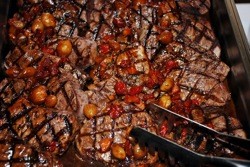Identifying a Quality Cut of Meat
Meat is a fantastic food that the most of us consume on a regular basis.
Though just like any other type of produce, sometimes we will encounter meats that are stringy, tough and tasteless. A lot of this has to do with with how the animals were fed and how you cook the meat yourself.
To help you identify the best quality cuts of meat (using beef as our example), here are some helpful tips that butchers have listed.

The feed
When it comes to how animals were fed, there is often the debate between the natural and unnatural means, such as hormones vs no hormones, free-range vs caged, and so on. While it is inevitable that we will often end up consuming meat that that has hormones in it, certain farms will operate differently.
Ideally, they will be fed naturally and allowed to reach their ideal state on their own. However, at times cows can be heavily fed grains so that they fatten up. There are a few ways to tell this by looking at the meat, but one of the key indicators commonly identified is ‘marbling’.
Marbling are those spots of fat you may see throughout your meat. Generally the more marbling there is, the more fat the livestock was. However, keep in mind that certain breeds – such as Angus beef – naturally have more marbling than others.
Ideally, the beef you should look out for is organic, grass-fed and comes from a cow that was free to move around as opposed to locked up. Grass-fed beef is typically less fatty (with its fat possessing a yellowish colour), a healthier red colour and tastier than grain-fed beef. However, both can be enjoyed as long as you cook them appropriately.
When looking at a cut of meat, keep an eye out for how dark the red of the meat is. Usually, when the meat is a darker shade of red, it will tend to be quite stringy and not too tender. If the cut of meat is a brighter red, however, this is usually a good sign that the meat will be tender and far less to contain and stringy bits.
If you’re unsure of how to tell the difference between these types of meat and the way they were fed, don’t hesitate to ask your serving butcher. He/she will happily point out ideal cuts and maybe even offer you a couple of helpful tips, too.
Your cooking style
Now with a bit more knowledge of how to determine higher quality meat from less ideal cuts, you have to account for how you cook it.
If your meat has a large amount of marbling, this means that you can be a little more forceful with your cooking. The marbling naturally helps maintain the tenderness of the meat but is also less healthy for you. But if that’s not an issue, then you can go ahead and cook beef with visible marbling for a while and it shouldn’t hurt its tenderness that much.
Higher quality and less fatty meats – such as grass-fed beef – requires the opposite. However, because grass-fed beef is notably better, it also means you can cook it to rarer conditions with less risk to your health. In fact, beef that is of a substantially high quality can be consumed raw – but that is certainly an acquired taste.
Once again, if you’re unsure of how to cook any specific cut of meat, ask your butcher for guidance.
Do you have any additional tips on how to tell good meat from bad meat? Be sure to share them with us in the comments below.
If you’re a butcher who needs any of your meat products transported, Cannon Logistics can help. We provide tailored refrigerated logistics services throughout Queensland and northern NSW. To find out more about our services and the areas we cover, give us a call on (07) 3217 9211.